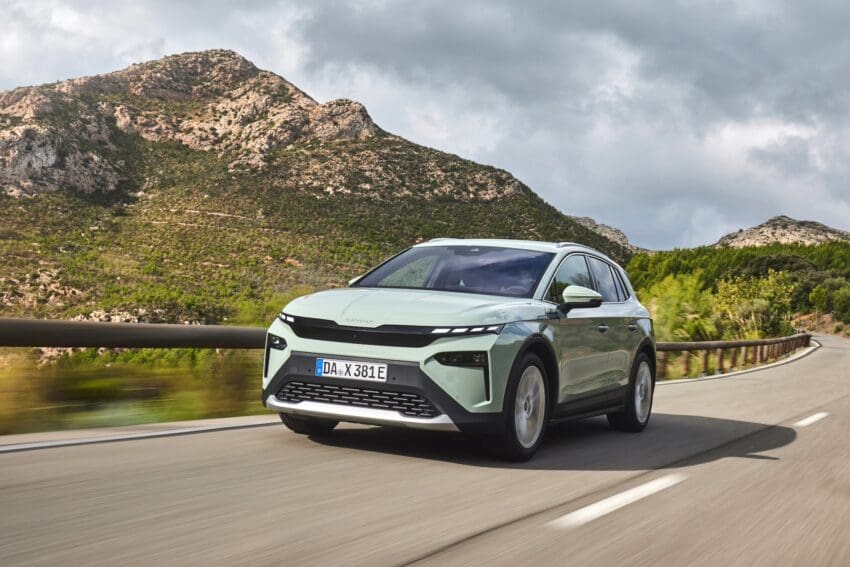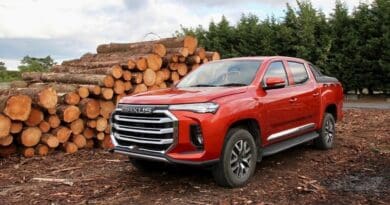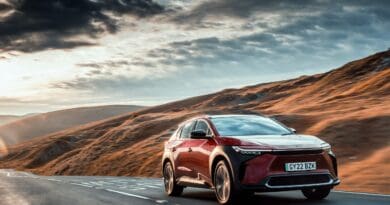
Skoda Elroq Review: Is the electric Karoq a new class leader?
The Skoda Elroq is entering a busy compact electric SUV sector, so we see how it rates against rivals ranging from the Kia EV3 to the Renault Scenic
If you’d asked me a month ago what the best compact electric SUV was, I would have said the Kia EV3 without hesitation. But that was then, and this is now, and I think Skoda Elroq might just give that brilliant Korean something to worry about.
The Elroq is an electric alternative to the Karoq, hence Elroq, and is Skoda’s second all-electric model after the Enyaq. On first impressions it is a condensed version of everything that has made that larger EV a success.
The Elroq is positioned as a compact SUV, priced from just over £30,000. That puts it in competition with aforementioned EV3, the Jeep Avenger/Peugeot E-2008/Fiat 600e trio, the Volvo EX30 and Smart #1. However, the Elroq is bigger than those models and in the same territory as the more expensive Renault Scenic, BYD Atto 3 and Hyundai Kona, all of which Skoda also sees as rivals.
That means there are a lot of alternatives to the Elroq, including some hugely impressive ones. So the Skoda really has its work cut out to make an impression.
Design, interior and technology
The Elroq is the first Skoda production car to adopt the brand’s new Modern Solid design language. That is all about ‘robustness and functionality’ and translates to a more futuristic but still recognisable approach to Skoda’s sharp design.
It’s most evident in the ‘tech deck’ front end of the Elroq with its split-level LED lights and broad, black ‘face’ . The tech deck hides the various sensor arrays of all modern cars and creates a new feature in place of the traditional slatted Skoda grille. The slimline, multi-element lights also echo Skoda styling but with a crisp new look, and eventually we’ll see a full-width light option similar to the Enyaq’s Crystal Face.
The rest of the car is less distinctive. It follows familiar Skoda design tropes and it’s clear to see elements of the Enyaq and the Karoq, especially when viewed from the side or rear.

At 4.48m long, Skoda is stretching the concept of a ‘compact’ SUV. That’s 18cm longer than an EV3, 10cm bigger than a Kona and around the same size as a Renault Scenic. But that’s always been Skoda’s trick — price a car for one segment then make it almost as big as the segment above. Just look at the Octavia.
The Skoda Elroq has an identical wheelbase to the Enyaq, which is evident in the massive amounts of passenger space. This is a ‘compact’ car where four adults will have no difficulty in getting comfortable. Legroom and shoulder room are as good as or better than anything else in its class. Even at 6’ 5’’ I found enough space for my knees and feet behind a 5’ 10’’ driver, and enough headroom to sit up straight. The seats — whether the regular or Sportline ones — are also brilliantly supportive and comfortable.
The payoff compared with the Enyaq is a smaller boot but, at 470 litres, it’s still better than virtually any competitor car.
In the cabin there’s 48 extra litres of stowage space dotted between the capacious door pockets, the lower centre console and beneath the adjustable armrest. There’s no frunk, but special mention must go to the cable net which hangs beneath the parcel shelf. This means your cable is always accessible, even when the boot is full — unlike cars with underfloor storage.

The interior borrows a lot from the Enyaq, which is a smart move. It brings a simple but stylish approach with a low-set, two-layer dashboard topped with soft rubber and with fabric beneath. The main 13-inch touchscreen sits proud of the dash while the simple small dials are housed in a neat ‘envelope’ in the dash top. Those instruments are supplemented by a big bright HUD that includes augmented reality for the sat nav.
Material quality is the high standard we’ve come to expect from Skoda. Even the basic Loft interior ambience feels more like a premium product than a £31k entry-level option. It uses a tactile, attractive fabric made largely from recycled plastic. Higher trims levels get the option of the Lodge finish, which features grey and white upholstery made from faux leather and recycled fishing nets, and comes with funky orange seatbelts.

On the tech front, the Elroq’s central touchscreen runs a refreshed operating system that’s quicker and easier to use than before, with more quickly accessible shortcuts for the functions you really want. It also supports remote parking payments and contactless plug-and-charge sessions. And although it doesn’t get the clever Smart Dials of some Skodas, there are physical keys to instantly pull up functions such as the climate control and driver assistance.
Skoda Elroq battery, motor and performance
The Skoda Elroq uses the same powertrains as the larger Enyaq, meaning buyers have a choice of three battery and motor combinations.
Each is named roughly according to the battery size. The Elroq 50 gets a 52kWh battery and 168bhp motor. The 60 has a 59kWh battery and 201bhp motor, and the 85 has a 77kWh battery and 282bhp motor. There is an all-wheel-drive variant, but the UK isn’t getting that.
Maximum range in the 50 is 232 miles, while the 60 boosts that to 250 miles. In comparison, the 52kWh version of the EV3 manages 270 miles, and the 60kWh Scenic does 260.
For the maximum range, you’ll want the Elroq 85 on 19-inch wheels, which will officially cover 360 miles on a charge. That’s great, although not quite a match for the EV3’s 375 miles or Renault’s 379.
Each step up also brings faster charging. The 50 maxes out at 145kW — already better than most rivals — while the 60 reaches 165kW and the 85 manages 175kW. Skoda says that this allows every variant to charge from 10-80% in between 24 and 28 minutes.

Production of the 60 — predicted to be the best-seller — hasn’t started, so I tested the 50, and the 85.
Really, almost 300bhp and more than 400lb ft is more than a car of this sort needs. The 85 jumps away from a standstill with real pep and pulls strongly but smoothly all the way up to motorway speeds. Standstill to 62mph takes just 6.6 seconds, which feels more than quick enough.
The 50 takes 8.7 seconds to reach 62mph and while it’s clearly less punchy, the difference isn’t as pronounced as you might expect. It still picks up keenly, even at higher speeds and has sufficient shove for a smallish family car. That was with two on board, with a full family, you might appreciate the extra power of the 60.
As with most small SUVs, you won’t get much feel from the steering but the Elroq does offer remarkable body control. There’s very little lean in fast corners but what’s more impressive is how composed the ride is. Regardless of the surface and even on 20-inch wheels, it smooths out lumps and bumps without ever feeling slack or bouncy.
Buying the Sportline brings Dynamic Chassis Control with variable damper stiffness and variable ratio steering for a livelier drive. It’s definitely firmer and with heavier steering in the sportier settings but the dynamic difference to regular cars isn’t significant enough to recommend it.
Matching the remarkable ride comfort is brilliant noise isolation that means right up to European motorway speeds there’s very little wind or road noise. Higher-spec cars benefit from acoustic laminated glass but even the entry-grade cars are as quiet and refined as premium vehicles from the class above.
Skoda Elroq price and specification
The Skoda Elroq costs from £31,500, making it the cheapest car in the compact SUV class. It neatly undercuts models like the EV3 and EX30 while offering comparable equipment and performance.
The entry point is the SE trim, which is only available with the ’50’ powertrain. As standard, it gets 19-inch alloy wheels, LED lights, a reversing camera and sensors. The 13-inch touchscreen is also fitted to all models and SE gets single-zone climate control and cruise control.

Above SE are three more trim levels —SE L, Edition and Sportline.
SE L starts at £33,500 and comes with the 59kWh battery and 201bhp motor as its only powertrain. It enhances the SE trim with heated seats and steering wheel, sat nav, dual-zone climate control and front parking sensors.
Edition and Sportline can be specced with either the 59kWh or the 77kWh battery. Edition starts at £34,450 and the bigger battery is £2,200 more. That brings a different alloy wheel design, dark chrome exterior trim and privacy glass. Inside, it adds driver assistance including adaptive cruise control, keyless entry and wireless phone charging
A top-spec Sportline 85 is £41,600, which undercuts the range-topping EV3 GT Line S by £1,300 and the top-end Scenic by £5,000 while offering comparable range and equal, if not better, performance.
As mentioned above, Sportline gets dynamic chassis control and progressive steering as standard. It also adds adaptive LED matrix headlights, a host of gloss black exterior trim, 20-inch alloys and unique sports seats finished in microsuede and faux leather. The 85 also gets lower sports suspension, which the 60 misses out on. While Sportline definitely looks sharper, the Edition feels like the sweet spot of the range.
Verdict
Skoda smashed it out of the park with the Enyaq and it appears to have done it again with the Elroq.
It offers a classy, premium-tinged interior, loads of space and a choice of three well-considered powertrains that deliver impressive performance and range. On top of that its ride and refinement are among the very best in class. And it delivers all of this for a hugely competitive price.
There are some equally brilliant competitors out there, particularly the Kia EV3 and Renault Scenic, but for value for money, it’s very hard to argue against the Skoda Elroq.

Skoda Elroq 85 Edition
- Price: £36,650
- Powertrain: single-motor, rear-wheel-drive
- Battery: 77kWh
- Power: 282bhp
- Torque: 402lb ft
- Top speed: 111mph
- 0-62mph: 6.6 seconds
- Range: 360 miles
- Consumption: 4m/kWh
- Charging: up to 175kW





